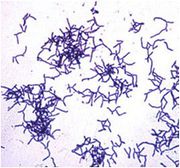Actinomyces israelii is a species of gram-positive rod-shaped bacteria within the Actinomyces. Known to live commensally on and within humans, A. israelii is an opportunistic pathogen and a cause of actinomycosis. Many physiologically diverse strains of the species are known to exist, though all are strict anaerobes.
Pathogenesis

Actinomycosis is most frequently caused by Actinomyces israelii and is sometimes known as the "most misdiagnosed disease," as it is frequently confused with neoplasms. A. israelii is a normal colonizer of the vagina, colon, and mouth. Infection is established first by a breach of the mucosal barrier during various procedures (dental, GI), aspiration, or pathologies such as diverticulitis. The chronic phase of this disease is also known the "classic phase" because the acute, early phase is often missed by health care providers. This is characterized by slow contiguous growth that ignores tissue planes and forms a sinus tract that can spontaneously heal and recur, leading to a densely fibrotic lesion. This lesion is often characterized as "wooden." Sulfur granules form in a central purulence surrounded by neutrophils. This conglomeration of organisms is virtually diagnostic of Actinomyces israelii.
Oral-cervicofacial disease is the most common form of actinomycosis. It is characterized by a painless "lumpy jaw." Lymphadenopathy is uncommon in this form of the disease. Another form of actinomycosis is thoracic disease, which is often misdiagnosed as a neoplasm, as it forms a mass that extends to the chest wall. It arises from aspiration of organisms from the oropharynx. Symptoms include chest pain, fever, and weight loss. Abdominal disease is another manifestation of actinomycosis. This can lead to a sinus tract that drains to the abdominal wall or the perianal area. Symptoms include fever, abdominal pain, and weight loss. Actinomyces species have also been shown to infect the central nervous system in a dog "without history or evidence of previous trauma or other organ involvement."
Pelvic actinomycosis is a rare but proven complication of use of intrauterine devices. In extreme cases pelvic abscesses might develop. Treatment of pelvic actinomycosis associated with intrauterine device involves removal of the device and antibiotic treatment.
Diagnosis

Actinomycosis may be considered when a patient has chronic progression of disease across tissue planes that is mass-like at times, sinus tract development that may heal and recur, and refractory infection after a typical course of antibiotics.
Treatment

Treatment for actinomycosis consists of antibiotics such as penicillin or amoxicillin for six to twelve months, as well as surgery if the disease is extensive.
References








Thanks for your information. Please accept my comments to still connect with your blog. And we can exchange backlinks if you need. What Is Actinomycosis?
ReplyDelete